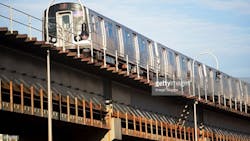NYU Rudin Center for Transportation releases report looking at path to achieving full accessibility in NYC Transit system
The New York University (NYU) Rudin Center for Transportation has released a report looking at the path to achieving full accessibility in the New York City Transit system. The new report, authored principally by NYU Rudin Center Director Sarah Kaufman, finds the Metropolitan Transportation Authority’s (MTA) ability to deliver the remaining accessible stations hinges on the $15 billion in capital funding to be generated from the Central Business District Tolling Program (CBDTP). The planned tolling system will charge cars, buses and trucks based on vehicle size and occupancy to drive into Manhattan, N.Y., below or on 60th St., including Times Square, Chelsea and SoHo.
In a 2022 settlement, the MTA committed to make at least 95 percent of subway stations accessible by 2055. To advance toward this goal, since 2020, the MTA increased its average pace of building to more than six stations each year, doubling the average of three from 2015. In 2023, the MTA upgraded eight new stations with accessibility improvements. The Rudin Center report finds congestion pricing must be implemented to maintain the pace MTA is currently on.
“The journey toward full stair-free accessibility in New York City's public transportation system is at a critical juncture,” Kaufman said. “Despite historic underinvestment, the recent prioritization of upgrades by the MTA has had positive impacts. Sustaining this momentum is imperative: The pace of progress directly impacts millions of New Yorkers. Investing steadfastly in universal accessibility will enhance daily rider experiences and pave the way for a more equitable and interconnected future for New York City.”
"In the three short years I have been with the MTA, we've taken big steps toward our vision of a universally accessible transit system, making more than a dozen subway stations newly accessible, expanding features like wayfinding technology and new fare gates and rethinking the design of our buses to accommodate all riders. This leadership team is fully committed to ensuring every customer can navigate our subway and bus network and to the decades of work and billions of dollars of investment it will take to realize this vision. To maintain our pace of progress, we need the funding expected from CBDTP to deliver this historic $52 billion Capital Plan and those that will follow and we need advocates and elected officials alike to support these investments,” said MTA Chief Accessibility Officer Quemuel Arroyo.
While the MTA has accelerated its pace to retrofit stations with accessibility improvements, the report also made additional recommendations to build on this progress to deliver results faster. Recommendations include:
- Implement additional cost containment measures
- Bolster infrastructure monitoring
- Improve the geographic distribution of accessible stations
- Broaden public engagement
- Leverage existing and emerging technologies for real-time data and improvements
According to the NYU Rudin Center for Transportation, accessing the public transit system can present challenges for the 13 percent of New Yorkers with physical disabilities. Currently, 30 percent of subway stations have elevators or ramps, significantly limiting services for those with ambulatory disabilities and other access needs.
In addition to Kaufman, the report was prepared by Marta Krawczynski, Henry Kanengiser and Titus James, all of the Rudin Center. The work was supported by the MTA and NYU C2SMARTER at the NYU Tandon School of Engineering.
